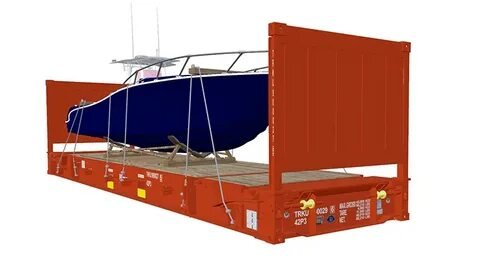Containers are the undisputed backbone of international logistics and transportation. Among the many types of containers, flat rack containers, due to their unique open structure, are a key option for transporting oversized and overweight cargo. However, compared to standard dry and refrigerated containers, flat rack shipping is exponentially more complex and challenging. This article will delve into the key challenges of flat rack logistics and explain how to overcome these challenges through professional planning.

What is a flat rack?
Before delving into the challenges, we first need to define what a flat rack is. A flat rack is a container without a roof or side walls (or with collapsible side walls), typically consisting of a floor and end walls. It comes in two main types:
1. Flat rack: Features fixed end walls.
2. Collapsible flat rack: Features foldable end walls for space-saving storage when not in use.
This design allows for easy loading of cargo that cannot fit into standard containers, such as heavy machinery, construction equipment, large vehicles, steel structures, and wind turbine blades.
Core Difficulties and Challenges of Flatbed Shipping
Every step of flatbed shipping is unique, and the challenges are primarily reflected in the following aspects:
1. Extremely High Requirements for Cargo Securing and Lashing
This is the most core and technically demanding challenge in flatbed shipping. Without the protection of the container walls, the cargo is completely exposed and requires specialized lashing tools (such as chains, wire ropes, straps, and tensioners) as well as wooden planks and brackets for securing.
Risks: Strong sea waves cause severe swaying and vibrations on ships. If improperly secured, cargo can easily shift, tilt, or even fall into the sea, resulting in significant economic losses and safety accidents.
Professionalism: The securing plan requires professional mechanical calculations, taking into account the cargo’s center of gravity, weight distribution, and various external forces that may be encountered at sea. This typically requires on-site guidance from experienced loading and unloading engineers and is beyond the capabilities of ordinary people.
2. Complex Loading and Unloading Processes
Loading and unloading flatbed containers cannot be directly performed using conventional dock cranes.
High Equipment Requirements: This typically requires the use of specialized tools such as heavy cranes (such as floating cranes and truck cranes), forklifts, and hydraulic flatbed trucks. This requires the appropriate hardware facilities and capabilities at the loading and unloading port.
Large Operating Space Requirements: This operation requires a vast operating area, making terminal yard planning and management more complex.
High Time Cost: The entire loading and unloading process takes significantly longer than for standard containers, resulting in additional demurrage and detention charges.
3. Precise Dimensions and Weight Control
Cargo transported in flatbed containers is often “out-of-gauge cargo,” meaning its dimensions exceed the standard container range.
Advance Declaration: Detailed cargo information, including the exact length, width, height, weight, and center of gravity, must be provided to the shipping company in advance and accurately. Any discrepancy could result in booking rejection or serious problems such as loading delays and customs clearance.
Additional Fees: Due to the large space required and complex operations, shipping companies will charge a series of surcharges, such as overlength, overweight, and overwidth fees. Logistics budgets must fully factor these factors into consideration.
4. Coordination and Careful Planning
Rack-load container transportation is a systematic project that requires close collaboration among logistics providers, shippers, consignees, shipping companies, terminals, and towing companies.
Route Survey: The transportation route must be surveyed in advance to ensure that all bridges, tunnels, power lines, and toll booths along the way meet the requirements for oversized cargo.
Document Preparation: The required documents are more complex and may include special equipment operating permits and oversized transportation permits. Contingency Plans: Alternative plans must be developed for unexpected situations such as weather changes, vessel delays, and equipment failure.
5. Higher Insurance and Risk Costs
Due to its high-risk nature, marine insurance premiums for flatbed cargo are generally higher. Insurance companies will carefully review the cargo’s packaging and securing solutions, transportation routes, and carrier qualifications before providing coverage. Clear division of liability and comprehensive insurance coverage are the last line of defense for cargo owners.
How to Overcome Difficulties? Choosing a Professional Logistics Partner is Key
Faced with so many challenges, the key to successfully completing a flatbed shipment lies in choosing an experienced international logistics service provider. A professional partner can provide you with:
Professional consulting and solution design: Providing the optimal loading and securing solutions based on your cargo’s conditions.
Accurate Quotes: Clearly listing all possible freight and surcharges to avoid hidden costs.
Full Project Management: Coordinating with shipping companies, terminals, and fleets to ensure a smooth process.
Handling Unexpected Situations: Leveraging their experience and resources to quickly and effectively resolve any issues encountered during the shipment.
